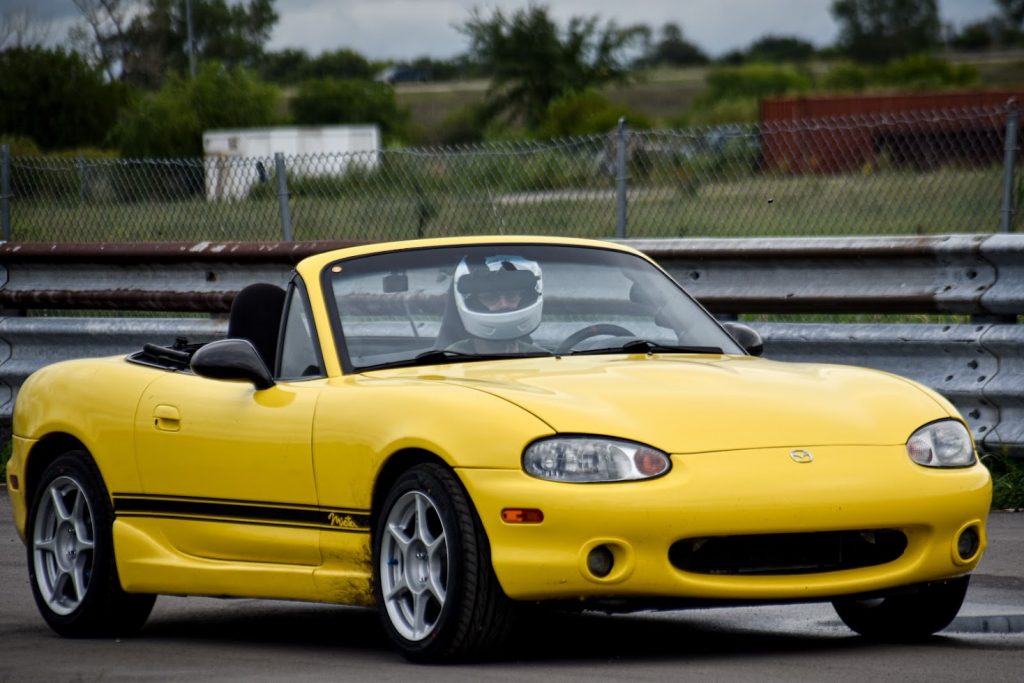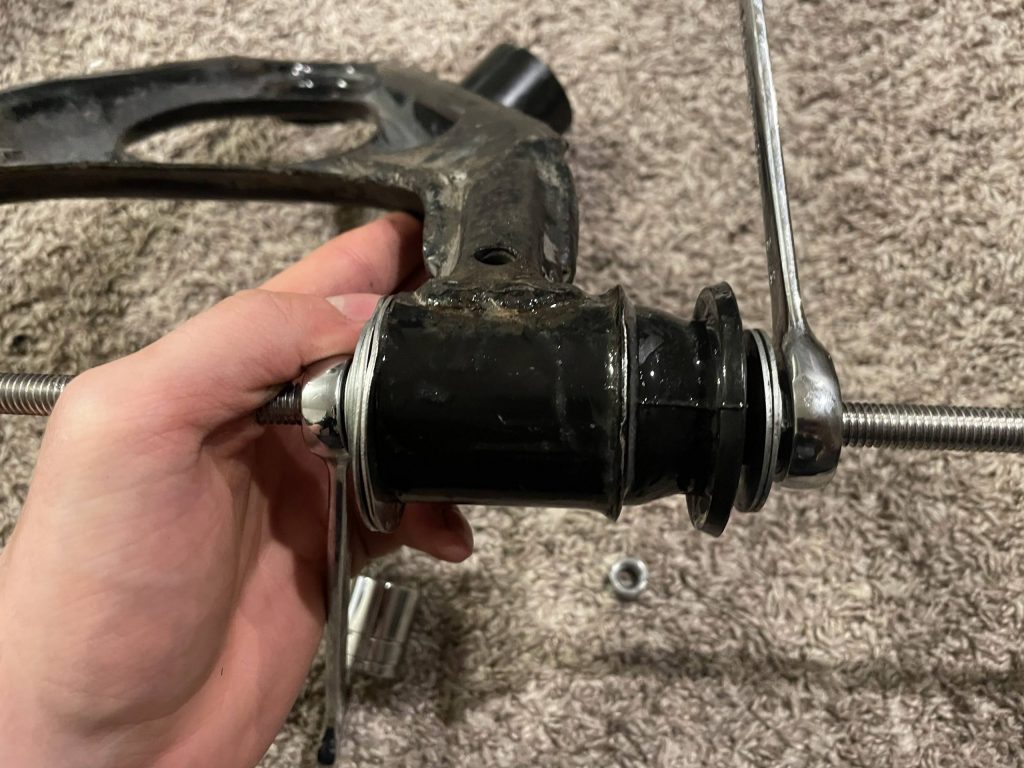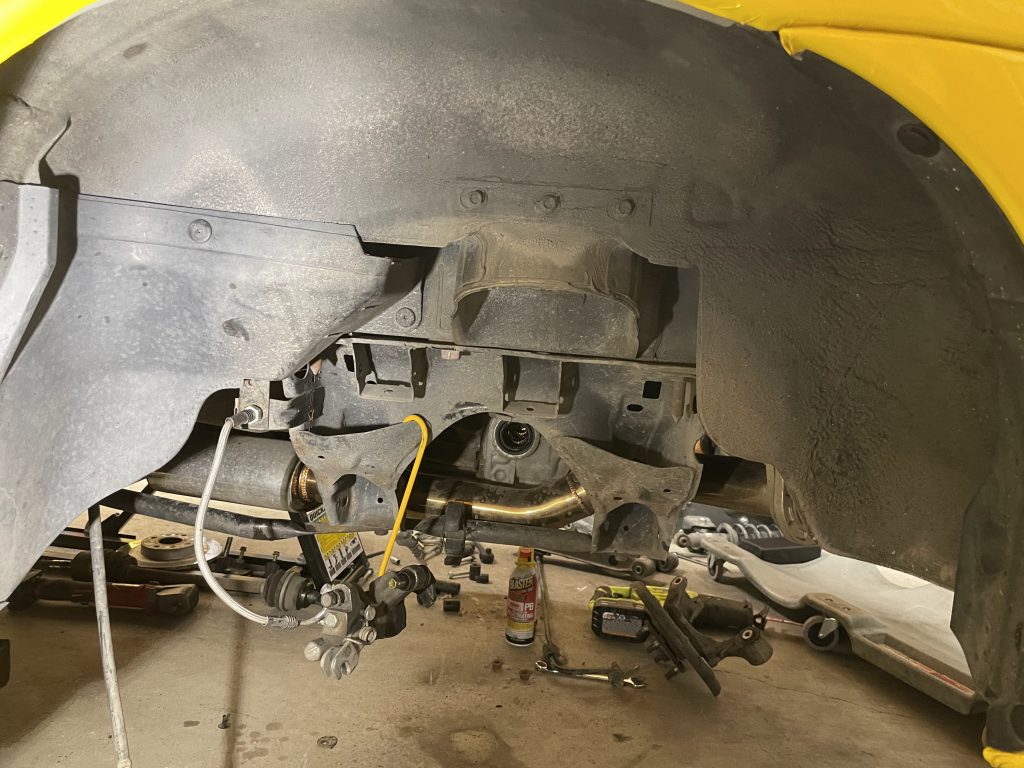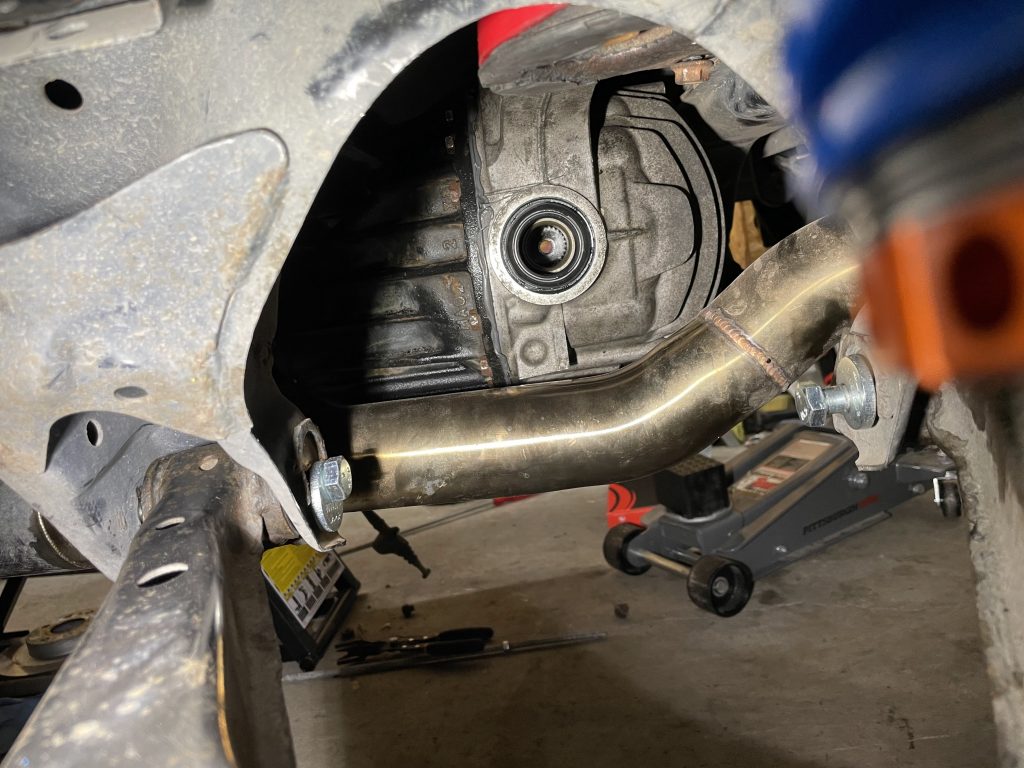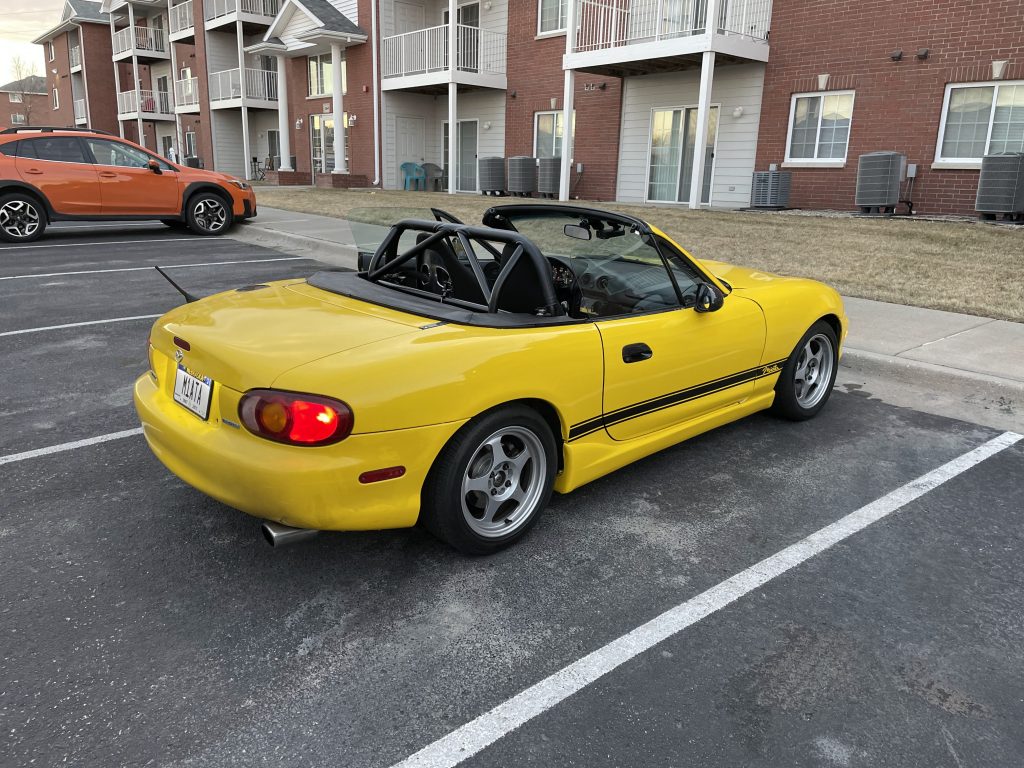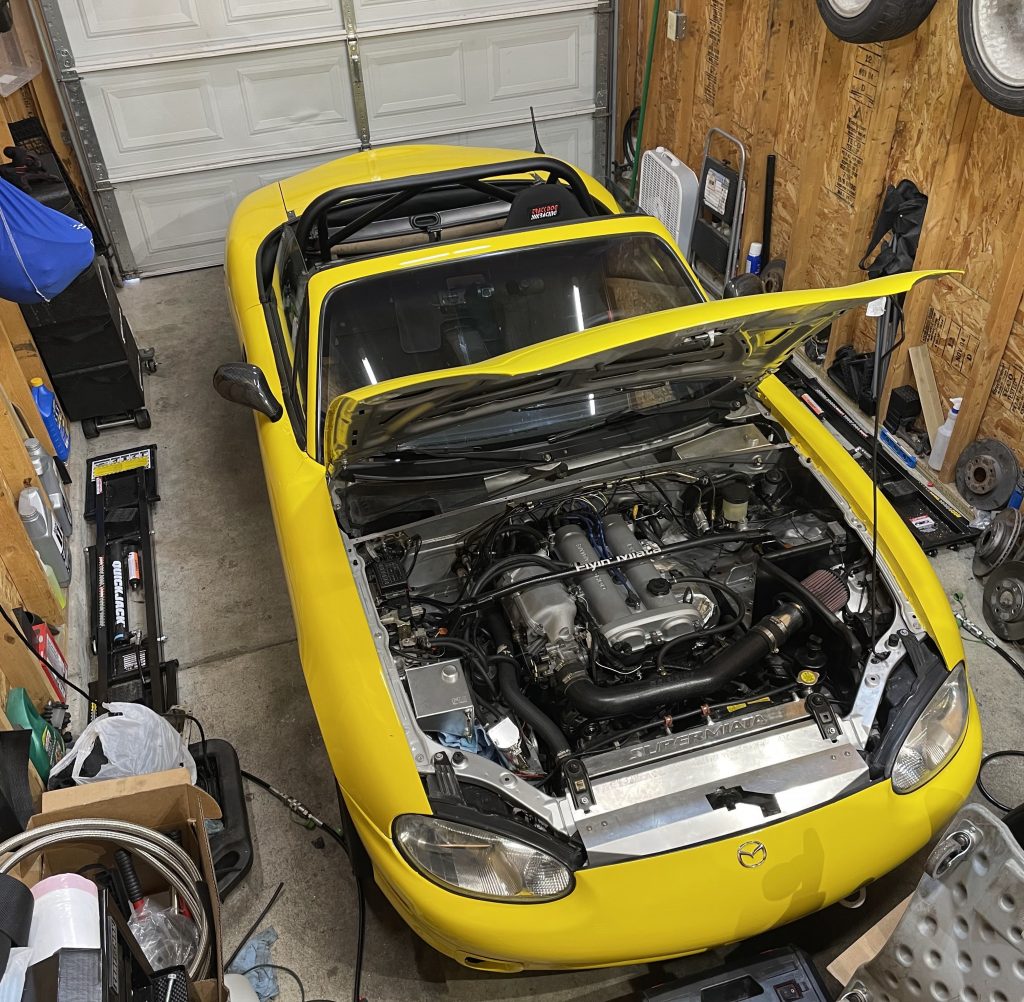NB Miata project – Suspension refresh: Supermiata Xida Race coilovers, IL Motorsports bushings
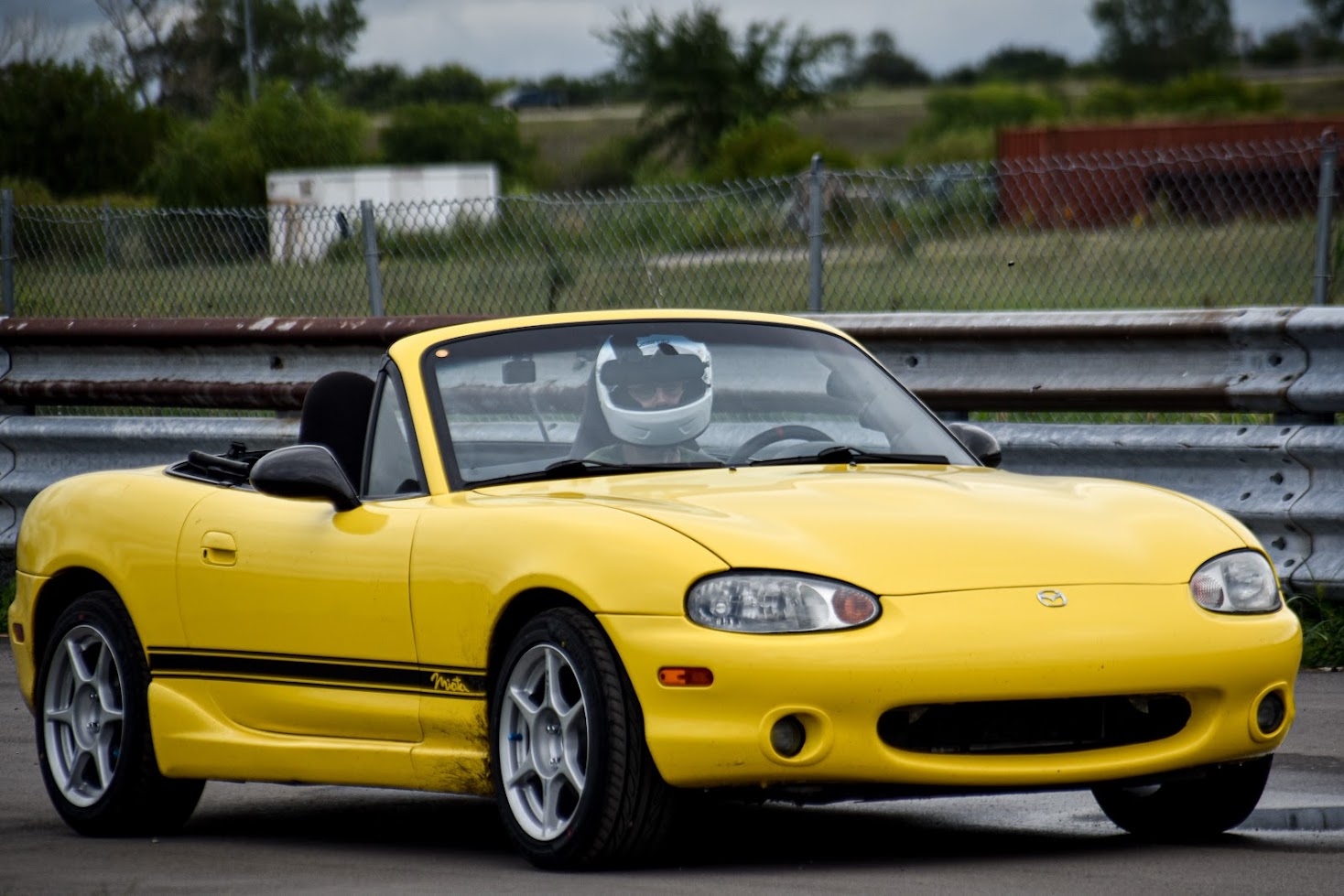
In a previous post I wrote about some of the plans for my NB Miata while it’s put away for the winter. One of the things I wanted to work on was refreshing the suspension That’s what this post is all about. These upgrades include stiffer control arm bushings, replacement hubs/bearings, replacement ball joints, Xida Race coilovers, a Torsen differential, and differential bushings. I wanted to get this done early on in the winter. A lot can go wrong when it comes to potentially rusty suspension components.
Previous car suspension setup
My NB Miata came pretty much completely stock. The entire suspension is either completely original, or of unknown age.
- Control arm bushings: Rubber on most of the bushings was still in pretty good shape, but I wanted something stiffer for tighter handling.
- Ball joints: Unknown age, but still tight.
- Hubs/bearings: Unknown age, these can become a wear item if you become a fast Miata driver.
- Shocks: Original base model shocks, very soft.
- Differential: A 4.30 ratio open differential.
- Differential bushings: Original rubber bushings.
Of course all of these parts are still fully functional, but there were still improvements to be made. An added benefit of upgrading all of these parts is they all will now have a known recent service date. My car had no real maintenance history.
IL Motorsports control arm bushings
I decided to install some stiffer control arm bushings and went with the IL Motorsports bushings. They are similar in stiffness to the Mazdaspeed bushings, but at a lower price. My main reasoning behind going with stiffer rubber over something like polyurethane was that they’d have the longevity of the stock rubber, and don’t require re-greasing. Going forward I may end up getting a second set of control arms. The Supermiata 863 bronze polyurethane bushings look good, but they weren’t available soon enough for an install this winter.
Installation of the bushings wasn’t too difficult, but there are some things that can definitely go wrong.
The first mistake I made was using a hydraulic press on the rear upper control arms. Using the press bent the control arm to the point where I needed to get replacement arms. I recommend using the hardware store parts method with some washers, nuts, and a long threaded rod. Never press the two sides together, and take your time, and you won’t bend any control arms using this method. To get the new bushings in I used some cheap hand soap to lubricate the bushings.
The second issue I ran into was the long rear lower control arm to knuckle bolt being stuck. After getting the arm and the knuckle off I was able to move the two pieces back and forth while hammering on the end of the bolt to get it out. I ended up replacing the longer bolts on the front and rear of the car. New alignment bolts were also installed.
At the moment I can’t really speak on the impact these bushings have had on the ride quality and the performance. I’ll need to get an alignment and head to the track to find that out.
Supermiata front end service kit
Ball joints and tie rods eventually go bad. I didn’t need to replace any of these parts on my Miata, but I thought that I might as well when I had all of the control arms taken off.
I went with the Supermiata front end service kit since it seemed to be a good price on high quality parts. It included:
- Upgraded new front upper ball joints
- New front lower ball joints
- New front outer tie rods
Installation was super easy. The lower ball joint and tie rods just bolt right on, while the upper ball joint needs pressed on. I was able to use my hydraulic press on the upper ball joint since I was able to support the part well without risking it bending. I somehow even managed to get all of the cotter pins out without them breaking, which isn’t very common on an old car in Nebraska.
Replacement hubs/bearings
Wheel hubs are a known weak point on a Miata that sees frequent track use. At the moment I’m not quite fast enough for that to be an issue, but I thought I’d install new ones anyways just to have a known age to the ones on my car. There are aftermarket (as well as OEM) options that are pretty much never going to fail on the track, but I went with just standard OEM type replacements for the time being, my car is mostly a street car after all.
For the fronts I went with standard Centric front hubs with bearings preinstalled for ease of installation. For the rear I got entire replacement rebuilt OEM hubs/knuckles/bearings from Treasure Coast Miata, again, for ease of installation. The old parts pretty much just came right off, and the new ones went right on without any issues.
Torsen differential swap + polyurethane differential bushings
Unfortunately my car was a base model with the 4.3 ratio open differential, and a 5 speed. I did like the 4.3 ratio, it makes the low power output of the Miata engine feel faster, but wanted to upgrade to a Torsen when I could get one for a good price. The problem is that the 4.3 Torsens are in super high demand, probably in part to them being required for certain racing classes like Spec Miata. I see them regularly listed for over $1,000, which is more than I was willing to pay.
Luckily patience worked out for the best and I managed to get a 4.3 Torsen shipped to my door for about $250, which is a great price. I purchased just the guts and put them into my existing aluminum carrier housing pumpkin. While I had the differential out I also installed new polyurethane differential bushings to give the differential a stiffer mount to match my stiffer engine mounts. I was originally going to go with Mazdaspeed Competition rubber mounts, but went with polyurethane for ease of installation (they just slide in and don’t need pressed in like the OEM style do).
Throughout the differential upgrade process I ran into some issues:
Getting the power plant frame (PPF) bolts out of the differential can be tricky. None of my impacts would do anything. I ended up just getting new PPF bolts and a replacement used PPF to make things easier. Looking back at it now I think I needed to undo those bolts while everything was still on the car with a very long breaker bar.
Another area I struggled with was getting the original differential bushings out of the carrier. It took some time. I removed the center by first drilling a bunch of holes in the rubber, and then hammered the metal bushing out with a punch by hand. I’ve heard it’s much easier with an air hammer, but I didn’t have one, and my air compressor probably isn’t up to the task.
Supermiata Xida Race coilovers
There are so many coilover options for the Miata that it can be hard to decide on a setup. You can spend a few hundred dollars on cheap Chinese coilovers, or well into the thousands of dollars to get high end shocks. My goal was for a track and autocross oriented setup that is tolerable on the street, which tends to push me towards coilovers with stiffer springs. A lot of what I was reading was that there are really two options you should consider.
If you don’t want to spend a lot of money you can do a DIY Bilstein setup. You can get new shocks, or even find some used ones, and then put together the parts to have custom spring rates and adjustable height collars. The damping is fixed, but you can always have the Bilsteins revalved later to match exactly what you are looking for.
If you are willing to spend the money and want a setup you can stick with forever then you probably want to get one of the high end coilover setups. There are a lot of options in this category still, like the Supermiata Xida, Flyin’ Miata Fox, Penske, and more. The only real drawback (other than price) to these is that they tend to not have the best longevity if they aren’t regularly serviced (especially if you drive in dirty conditions).
I personally went with Supermiata Xida Race shocks in the standard 800/500 spring rate configuration with helper springs. The price of these have gone up quite a bit since I purchased mine, but I got a good deal when I purchased mine last year since they pushed me over the threshold to qualify for the Supermiata Club Orange discount. A big reason why I went with these over some of the other high end options was how good the Supermiata customer service was (they answered some of my questions about ride height and spring rates very quickly).
Installation was super easy (I installed them at the same time I did all of my bushings so all of the suspension was already removed from the car). They definitely do lower the car, even when at their highest adjustment setting. My heavier NB Miata is around 0.5-0.75″ lower than the stock ride height and I’m close to the max height of the shocks. This isn’t really an issue for me and I haven’t ran into any scraping issues at this height.
In terms of performance the Xida coilovers are incredible. They are firm and confidence inspiring, while also not being any harsher on the street (depending on how you adjust the damping). I haven’t yet had a chance to take my car to the track or autocross since installing them, but I really look forward to using them for their intended purpose later this year.
On the street there are two areas which I have noticed are a big step up from stock. When cornering the car is much more flat, the stiffer springs really reduced the amount of body roll substantially. When going straight the car is much more planted and smooth, especially at high speeds. I found the stock shocks to feel very floaty and unsafe at high speeds, while these Xida coilovers are smooth and stable.
I don’t have much experience with other coilovers, but I definitely do think these Xida shocks are worth the money, especially on a dual duty car that is driven on the road and on track.
Sway bars, to upgrade, or to stay stock
A very common modification done to Miatas is the installation of a thicker front sway bar. They’re cheap, easy to install, and will reduce body roll and give you more front end grip. At the moment I’m still running the stock front and rear sway bars in my car.
At the moment I’m undecided on whether or not I’ll install bigger sway bars. Installing the stiffer springs has really reduced my body roll, while keeping the suspension just as independent as stock. Having an oversized sway bar can reduce the benefits of having a fully independent suspension. Oversized sway bars can also reduce the ride quality over rough roads.
I think the main benefit of going with aftermarket sway bars and adjustable endlinks is the ability to quickly and easily adjust the handling characteristic of the car. Usually aftermarket sway bars have multiple holes you can use to install the endlinks to adjust the leverage/impact of the bar. For example, if you find your car is understeering too much, you can adjust the rear sway bar to a more firmer setting so that it creates a little more oversteer.
I’ll most likely hold off on installing aftermarket sway bars for the time being, and then maybe install some further down the road. I don’t mind the slight understeering nature of the stock Miata setup, it’s a fairly safe place to be coming from primarily driving front wheel drive cars in the past.
Final thoughts
Going through the entire suspension of the Miata and replacing all of the wear items was surprisingly easy. There were very few bolts I had to fight with (only the long rear lower control arm upright bolts, and the differential to PPF bolts).
A lot of these modifications seem to have very minimal impact on the performance and handling on the car. In particular I can’t really tell if the stiffer rubber control arm bushings are making a difference. The replacement hubs and ball joints also aren’t something I can feel. Some of this is probably just because most of my original suspension parts weren’t worn out or anything.
Some of the modifications had a huge impact on the performance and handling of the car. Supermiata Xida coilovers are a huge step up from the stock shocks, I immediately felt the difference on the street, and look forward to seeing how they do on the track. I’d classify the Torsen differential and differential bushings in this same category, although not quite as big of an improvement as the shocks. I can feel the Torsen being more eager to quickly get power down coming out of turns.
I still have more work to do on my Miata over the winter so keep an eye out for new posts.
